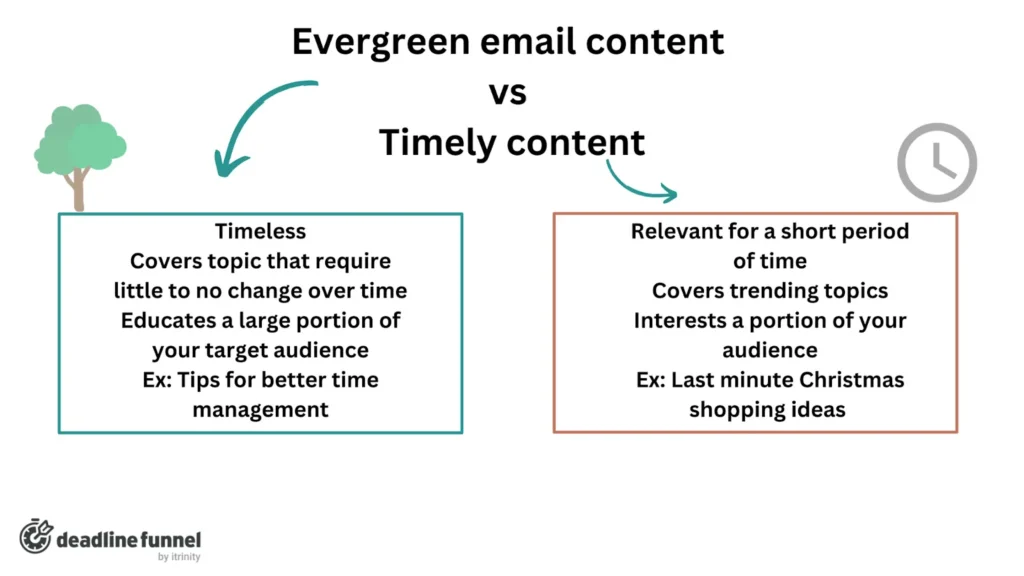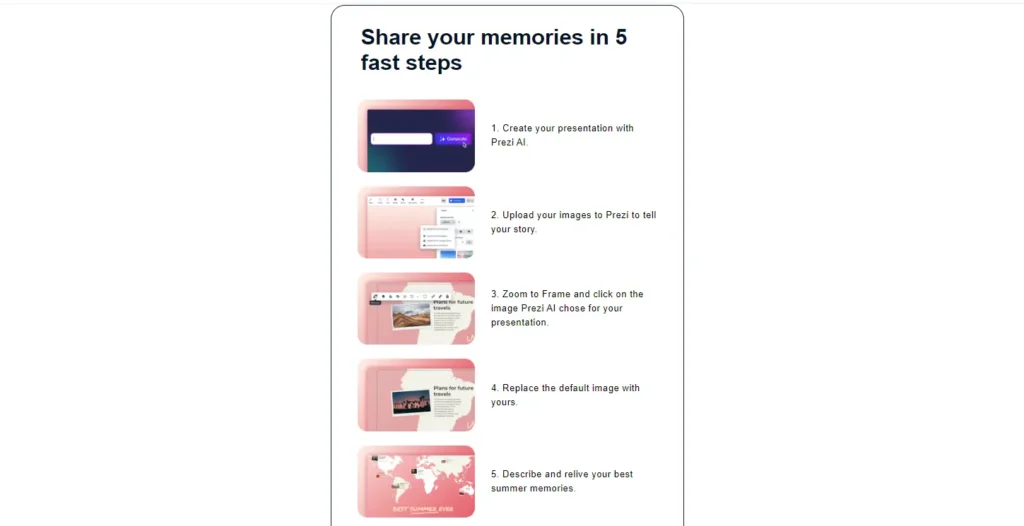

Evergreen email content is timeless, always-relevant material that retains its value long after its initial publication, with occasional twitches. Unlike time-sensitive or “hot” topics, evergreen emails focus on insights, processes, and questions within an industry, that will always be relevant. By addressing foundational topics, evergreen email content establishes authority and builds trust with readers. These emails are designed to educate, inform, and provide lasting value, making them a go-to resource over time. They’re also highly versatile, lending themselves to repurposing across various channels or platforms. A well-crafted evergreen email can be periodically refreshed with minimal effort, ensuring it stays relevant while continuing to drive engagement and reinforce expertise in your field.
For their 2023 State of Email Workflows report, Litmus surveyed over 440 email marketers worldwide to get a well-rounded status report on email marketing teams and their work.
Around 34% of email marketers reported that content creation was the biggest bottleneck in their email production, as they often struggle to craft relevant and useful emails that convert.
The nature of the challenge requires a sustainable solution: for example, evergreen email marketing.
Evergreen email content is timeless, always-relevant material that retains its value long after its initial publication, with occasional twitches. Unlike time-sensitive or “hot” topics, evergreen emails focus on insights, processes, and questions within an industry, that will always be relevant.

Benefits of evergreen content in emails
Two main benefits of evergreen content in emails are long-term engagement and time and resource efficiency.
Long-term engagement
Evergreen content keeps your audience engaged without constant updates and personalization efforts because automated email sequences slowly but surely turn warm leads into newsletter fans.
By tackling timeless topics and challenges, evergreen content retains its relevance and utility since subscribers are encouraged to revisit and engage with the content repeatedly.
Email marketers build trust and establish authority with their audience while nurturing leads throughout their journey with your product or service.
For example, if you sell investing guidance services, your client’s main concerns are – how, when, and why to invest.
Therefore, your evergreen content can cover topics like:
- How to start investing?
- Top X investing mistakes parents make?
- Should you invest in gold or real estate?
Here is another visual example of evergreen content by the Muse:

With these actionable and forever valuable emails, your target audience will read, follow up or come back to this piece of content regularly, since they have something to learn from it. All these actions help you boost your long-term engagement and open rate.
Saves time and resources
Once created, evergreen emails don’t require contrast updates, saving you time in new email content production. Around 53% of respondents indicated that it typically takes them longer than two weeks to create an email, according to the 2023 State of Email Workflows report.

By building an evergreen email marketing strategy, marketers can build a foundation of high-quality, reusable content, and ease the burden of constant creation.
All while ensuring a steady stream of engaging, conversion-oriented emails that resonate with the target audiences.
Since these topics are relevant to your target audience no matter when they open the email, you don’t need to spend much time on segmentation, separate email flows, or extra personalization.
Occasionally make sure your content is up-to-date, and adjust it according to feedback from your audience.
For the topics below, we can add new insights every year, create a resource library, or expand on the topic.
- How to start investing? (2024 vs 2023)
- Top X investing mistakes parents make? (seniors)
- Should you invest in gold or real estate? (or stocks)
Types of evergreen email content
We’ve divided evergreen email content into three types:
- Educational
- Frequently Asked Questions (FAQs)
- Welcome and onboarding emails

- Educational content
Educational content in emails has one main goal – to provide useful insights to your target audience. Those insights can be in the form of tutorials, how-tos, or guides that provide long-lasting value.
Evergreen educational content shouldn’t focus on your latest feature or resolve very specific issues, but in general tackle problems that the majority of your target audience has.
Educational emails should be short and packed with value, while you can link to a longer blog post or other resources for those that need a deep dive into a particular topic.
Here are 3 examples of EEE (educational, evergreen, email) content:
#1 LocaliQ’s free guide wrap-up

#2 Prezi’s product tutorial

#3 Deel’s how-to guide

2. Frequently asked questions (FAQs)
An email with your FAQs can help answer common customer questions to provide ongoing support. FAQ emails are evergreen since they meet the needs of both new and old customers.
New customers will clear initial bottlenecks by understanding your product/service right away, while older customers clear doubts or unlock new features/use cases.
FAQs emails need to be concise, and with authentic replies to previous customer inquiries they act as direct problem solvers that link to additional documentation or the support team’s contact.
Here are two example of these types of evergreen email:
#1 MIRO’s Feature FAQ

#2 LastPass’s how to get started email

3. Welcome and onboarding emails
The most famous type of evergreen content are probably the automated welcome and onboarding emails. These emails welcome new subscribers or customers with content that every “beginner” or “new customer” will gladly interact with.
First impression matters. Welcome emails have an 83.63% open rate, according to GetRespons’s benchmark survey, meaning this is the best chance you have to engage the new customer and pave the way for your future emails.
Welcome and onboarding emails should:
- Provide an overview of your tool/service
- Set the tone for your next emails or further steps
- Invite the customer to take action (explore your tool, book your service)
- Link to educational resources
Here are three examples of welcome and onboarding emails:
#1 Geo Targetly’s get started email

#2 Last Pass’s account set up email

#3 Napkin’s use cases email


How to implement evergreen content in your email strategy
Create automated email sequences
Setting up automated email sequences to deliver evergreen content can provide ongoing value to your subscribers while minimizing your workload.
Here’s how to create evergreen email sequences using platforms like Mailchimp or ActiveCampaign:
1. Map out your evergreen content
Begin by selecting what type of topics you should cover, these might include:
- Foundational knowledge in your industry
- Beginner tips and strategies
- Comprehensive guides or tutorials
- Frequently asked questions
- Case studies
2. Structure your sequence
Plan a logical flow for your content, in terms of building a flow from the first to the last email in your sequence. Map out:
- Which topics to begin & end with
- When to progress to more advanced or specific information
- How to group related topics together
- How to space out similar types of content (e.g., don’t cluster all case studies together)
3. Determine sequence length and frequency
Decide on:
- Total number of emails in the sequence
- Time interval between emails (e.g., weekly, bi-weekly, monthly)
- Your audience’s preferences and the depth of your content
4. Technically, set up your sequence
In Mailchimp:
- Go to “Automations” and select “Create Automation”
- Choose “Welcome new subscribers” as your trigger
- Add emails to your sequence and set time delays
- Design each email using Mailchimp’s editor
In ActiveCampaign:
- Navigate to “Automations” and click “New Automation”
- Select “Starts when a contact subscribes to a list” as your trigger
- Add emails to your sequence using the visual builder
- Set wait times between emails
- Design your emails using ActiveCampaign’s email designer
This is how an evergreen email sequence will look like in an inbox:

5. Craft engaging email content
For each email in your sequence:
- Write a compelling subject line
- Introduce the evergreen topic briefly
- Provide a clear, concise summary of the main points
- Include a link to the full content on your website or blog
- Add a relevant call-to-action (e.g., “Read the full article”, “Watch the tutorial video”)
6. Personalize and segment (optional)
To make your evergreen content more relevant:
- Use merge tags to personalize greeting and content
- Segment your audience based on interests, behavior, level of knowledge, if applicable
- Tailor content or examples to different audience segments
7. Set up entry and exit conditions
Configure your automation to:
- Add new subscribers to the sequence automatically
- Remove subscribers who unsubscribe or meet certain conditions (e.g., making a purchase)
8. Create a sustainable system for your evergreen emails
To keep your evergreen content fresh:
- Set a schedule to review and update content periodically (e.g., once a year/month)
- Have a system for replacing outdated information
- Consider adding new evergreen content to your sequence over time or building an in-depth resource center
Monitor and optimize
Even though the main benefit of evergreen content is “time-saving”, keep in mind that the content you write shouldn’t be set in stone. After getting initial feedback, a product/service update, or fresh information, you need to monitor and optimize your email sequence.
Your “unsubscribe” or bounce rate indicates how your subscribers react to your content. If a topic has a low open or high bounce rate, it means that your followers don’t see value in it.
Common easy fixes are reorganizing your email sequence structure, updating your content, explaining a topic more in-depth, etc.
Conclusion
Evergreen email content opens the door to long-term engagement and efficiency, so it is a must-have in any successful email strategy.
In this article, you learnt the benefits, types, and best examples of evergreen content with an overview of how to set an email sequence.
Make the most out of your best content, and make it evergreen to boost engagement and educate your audience.
If you’d like to capitalize on your best emails, Deadline Funnel can help out with an authentic deadline for your latest offer. Add a sense of urgency to your emails.

Include a real deadline timer for your customers to help them make a decision quickly, and don’t let them slip through the cracks.




